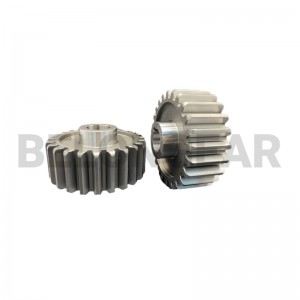-

Planetary gear set for planetary gearbox
Planetary gear set for planetary gearbox,This small planetary gear set contains 3 parts Sun gear, Planetary gearwheel, and ring gear.
Ring gear:
Material:18CrNiMo7-6
Accurancy:DIN6
Planetary gearwheel, Sun gear:
Material:34CrNiMo6 + QT
Accurancy: DIN6
-

Spur gear set for gearboxes reducer
High precision spur gear set used in industrial gearboxes is engineered for exceptional accuracy and durability. These gear sets, typically made from high-quality materials such as hardened steel, ensure reliable performance in demanding environments.
Material:SAE8620
Heat treatment :Case Carburization 58-62HRC
Accurancy:DIN 5-6
Their precisely cut teeth provide efficient power transmission with minimal backlash, enhancing the overall efficiency and longevity of industrial machinery. Ideal for applications requiring precise motion control and high torque, these spur gear sets are critical components in the smooth operation of industrial gearboxes.
-

High precision cylindrical gear used in gearboxes
A high precision cylindrical gear is meticulously engineered for applications demanding exceptional accuracy and reliability. Made from premium materials such as hardened steel, these gears feature precisely machined teeth that ensure smooth and efficient power transmission with minimal noise and vibration. Their superior accuracy and tight tolerances make them ideal for high-performance industrial machinery, automotive systems, and aerospace applications.
-

High Precision Spur Gear Set Used In Industrial Gearboxes
High precision spur gear set used in industrial gearboxes is engineered for exceptional accuracy and durability. These gear sets, typically made from high quality materials such as hardened steel, ensure reliable performance in demanding environments.
Material:SAE8620 customized
Heat treatment :Case Carburization 58-62HRC
Accurancy:DIN6 customized
Their precisely cut teeth provide efficient power transmission with minimal backlash, enhancing the overall efficiency and longevity of industrial machinery. Ideal for applications requiring precise motion control and high torque, these spur gear sets are critical components in the smooth operation of industrial gearboxes.
-

Internal Copper Ring Gear Used In Planetary Gearbox
Internal gears, also known as ring gears, have teeth on the inside of the gear. They are commonly used in planetary gear systems and various marine applications due to their compact design and ability to achieve high gear ratios. In marine applications, internal gears can be made from copper alloys to leverage the material’s corrosion resistance and durability.
-

Copper Brass Large Spur Gear Used In Marine Gearbox
Copper spur gears are a type of gear used in various mechanical systems where efficiency, durability, and resistance to wear are important. These gears are typically made from a copper alloy, which offers excellent thermal and electrical conductivity, as well as good corrosion resistance.
Copper spur gears are often used in applications where high precision and smooth operation are required, such as in precision instruments, automotive systems, and industrial machinery. They are known for their ability to provide reliable and consistent performance, even under heavy loads and at high speeds.
One of the key advantages of copper spur gears is their ability to reduce friction and wear, thanks to the self-lubricating properties of copper alloys. This makes them an excellent choice for applications where frequent lubrication is not practical or feasible.
-

Copper Spur gear used in Marine
Copper spur gears are a type of gear used in various mechanical systems where efficiency, durability, and resistance to wear are important. These gears are typically made from a copper alloy, which offers excellent thermal and electrical conductivity, as well as good corrosion resistance.
Copper spur gears are often used in applications where high precision and smooth operation are required, such as in precision instruments, automotive systems, and industrial machinery. They are known for their ability to provide reliable and consistent performance, even under heavy loads and at high speeds.
One of the key advantages of copper spur gears is their ability to reduce friction and wear, thanks to the self-lubricating properties of copper alloys. This makes them an excellent choice for applications where frequent lubrication is not practical or feasible.
-

Internal Ring Gear Used In Planetary Gearbox
Custom Internal Ring Gear, A ring gear is the outermost gear in a planetary gearbox, distinguished by its internal teeth. Unlike traditional gears with external teeth, the ring gear’s teeth face inward, allowing it to encircle and mesh with the planet gears. This design is fundamental to the operation of the planetary gearbox.
-

Precision Internal Gear Used In Planetary Gearbox
Internal gear also often calls ring gears ,it’s mainly used in planetary gearboxes . The ring gear refers to the internal gear on the same axis as the planet carrier in the planetary gear transmission. It is a key component in the transmission system used to convey the transmission function. It is composed of a flange half-coupling with external teeth and an inner gear ring with the same number of teeth. It is mainly used to start the motor transmission system. Internal gear can be machined by,shaping ,by broaching ,by skiving ,by grinding.
-

OEM planetary gear set sun gear for planetary gearbox
This Small Planetary gear set contains 3 parts: Sun gear, Planetary gearwheel, and ring gear.
Ring gear:
Material:18CrNiMo7-6
Accurancy:DIN6
Planetary gearwheel, Sun gear:
Material:34CrNiMo6 + QT
Accurancy: DIN6
-

Custom spur gear steel gears for turning machining milling drilling
This external spur gear was used in mining equipment . Material : 42CrMo ,with heat treatment by Inductive hardening . Mining Equipment means machinery directly used for mineral mining and enrichment operations , Including mining machinery and beneficiation machinery .Cone crusher gears are one of them we supplied regularly
-

Precision cylindrical spur gear used in spur gearbox
Cylindrical gear set, often referred to simply as gears, consists of two or more cylindrical gears with teeth that mesh together to transmit motion and power between rotating shafts. These gears are essential components in various mechanical systems, including gearboxes, automotive transmissions, industrial machinery, and more.
Cylindrical gear sets are versatile and essential components in a wide range of mechanical systems, providing efficient power transmission and motion control in countless applications.




